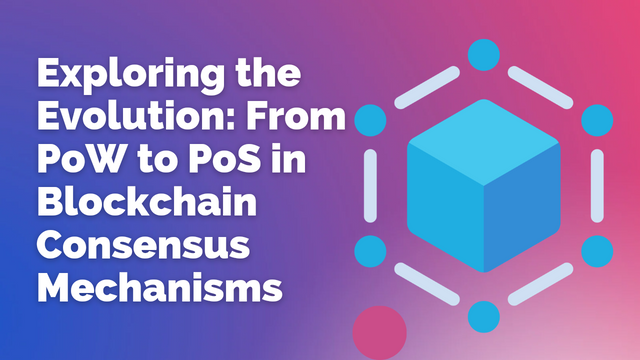Exploring the Evolution: From PoW to PoS in Blockchain Consensus Mechanisms
Blockchain networks are founded on consensus techniques, which permit users to reach an agreement on the reliability of transactions and uphold a decentralized, secure record.
Consensus processes control how additional blocks are appended to the ledger as well as how network users are compensated for their efforts in Layer 1 blockchain networks.
Let's explore Proof of Stake (PoS) and Proof of Work (PoW), which are two well-known Layer 1 consensus procedures.

Canvas source The initial consensual method which was put forward by Satoshi Nakamoto, the creator of Bitcoin, is called Proof of Work.
A new block can be added to the blockchain by the first person to mine to correctly solve a tricky mathematical equation in a proof-of-work (PoW) system.
The procedure of mining necessitates a large amount of computer power and energy. In exchange for their labors, miners receive transaction fees and freshly created cryptocurrency tokens that are PoW is dependable and safe.
However because of mining power is concentrated in big mining pools, it utilizes a lot of energy and can cause centralization.
An alternative agreement technique called Proof of Stake seeks to solve the issues related with centralized and energy consumption that come with Proof of Work (PoW).

Validators get selected to construct new blocks in a proof-of-stake (PoS) system according to the quantity of cryptocurrency individuals own and are prepared to "stake" and collateral.
A deterministic method that takes into account variables like stake size and activity on the network selects validators. PoS is less computationally challenging than PoW, which makes it more ecologically and energy-efficient.
Transaction fees and staking motivation are given to validation servers in exchange for their involvement in the production and validation of blocks.
PoW to PoS consensus treatments are being used in various Layer 1 blockchain networks with the aim to increase scalability, efficiency, & sustainability.
Ethereum 2.0, whose will go from proving their work to proof-of-stakes through a series of upgrade, is currently being implemented by Ethereum's, which is the second-largest blockchain platform by market value.

By switching with a Proof of Stake (PoS) to consensus process, Ethereum 2.0 seeks to improve security on the network, decrease energy usage, & increase payment throughput.
To accomplish these goals, other blockchain systems like Cardano and Polkadot have either supported or are researching PoS unanimous agreement processes.
In conclusion, Layer 1 methods of consensus are essential to ensuring the security, effectiveness, and long-term viability of networks based on blockchain technology.
Since the beginning of Bitcoin, Proof of Work has dominated consensual methods; nonetheless, Proof of Stake presents a viable substitute than overcome PoW's drawbacks.
Blockchain networks can become more scalable, require less energy, and become more decentralized by converting to proof-of-work (PoS), which will open the door to a more welcoming and environmentally friendly blockchain ecosystem.
Kind Regards
@artist1111

Adieu, folks!
May the winds of fortune
carry you to greatness!
May the winds of fortune
carry you to greatness!
X-promo : https://twitter.com/HamadkhanMWT/status/1782442218067800195?t=cnU8oc-xnBw_cmwvb_L0ag&s=19
Note:- ✅
Regards,
@jueco